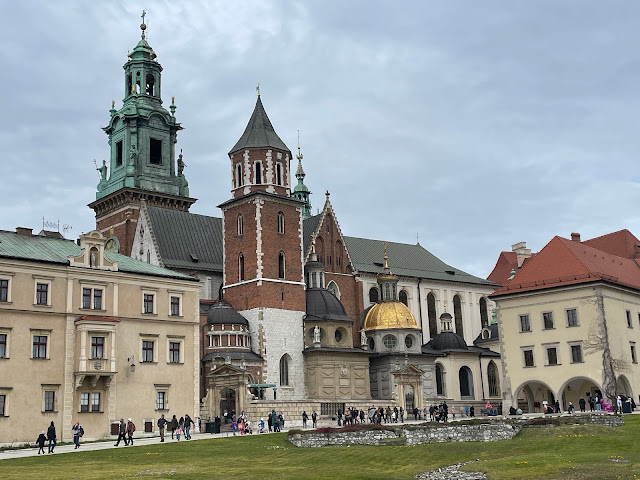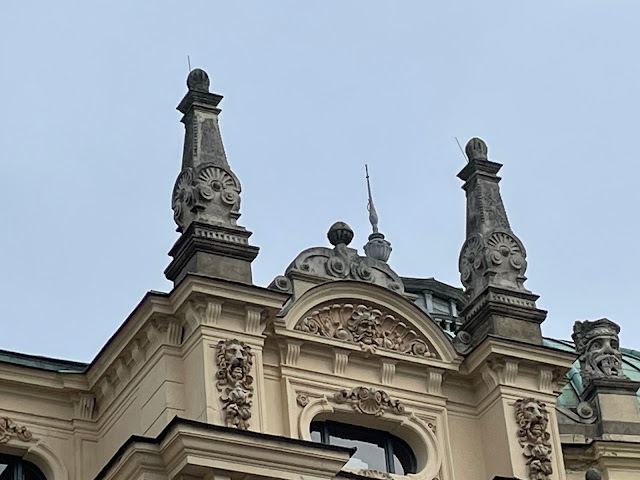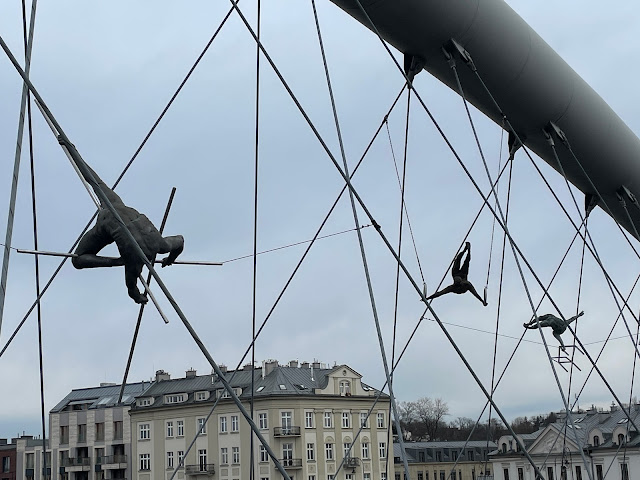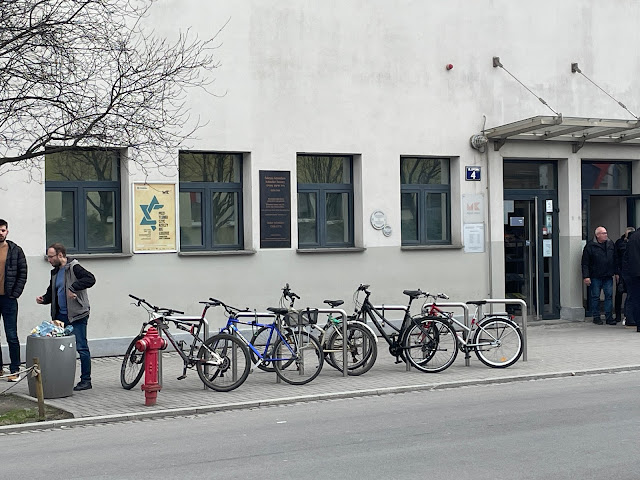Today we had a bit of a sleep-in and then started with our trip through Kraków. I'd made a map of the main things I wanted to see and we stopped along the way to check out some of the interesting sights. Our first stop was to be the St Florian's Gate - but, to get there we passed the Roman Catholic Parish of the Holy Cross (Kościół pw. Świętego Krzyża) and the Juliusz Słowacki Theatre (Teatr im. Juliusza Słowackiego).
These were grouped around the Plac Św. Ducha (St Ducha Square), which had existed since the Middle Ages, housing monasteries, hospitals and churches. The first hospital was built there in 1244.
St Ducha Hospital was originally only available to the poor and homeless until 1788. Part of the hospital was later turned into a cloth factory and the monastery was turned into the Imperial Mint office in 1796. The hospital eventually became a military hospital in the early 1800s and moved in 1879 to a new location. There was also a school at the site since 1424 attached to the clergy buildings but this was demolished in 1891 to make way for the theatre.
The Roman Catholic Parish of the Holy Cross was built in the 14th century to replace the wooden chapel that had stood at the site from the 12th century. It was constructed with brick and stone that was left over from the construction of Kraków's city walls. The large tower was added in the 15th century and the chapels were added in the 16th:
The square also has a model of how the site previously looked. the text below the model reads:
The site model of the Hospital and Convent of the Order of the Holy Ghost reflects the state prior to their demolition of 1892. In 15C (15th Century) the hospice run by The Order was the most important of its kind in Kraków. The city council decision to replace the hospital complex with a theatre was bitterly opposed by the local community. Brothers and sisters of The Order of the Holy ghost arrived from Vienna in 1220 at the invitation of Iwo Odrowąż the bishop of Kraków, their charismata being the care of the sick, poor, homeless, orphans and foundlings. The male branch was dissolved in 1783, suffering the fate of other orders of the time. The female one, however, exists to the present day. The chapter house of the Congregation of Canonesses of the Holy Ghost De Saxia, popularly known as "Duchaczi" (From "Duch", Polish for Ghost), is situated at 10 Szpitalna Street. The site model also features some of the buildings that have survived centuries to testify to the history of the Holy ghost order in Kraków. They are the Church of the Holy Cross, endowed by Bishop Jan Prandota in 1244, and the building at the corner of ŚW. Ducha Square and ŚW. Krzyż street, the former convent of the Congregation of Canonesses of the Holy Ghost.
While it is always sad to lose history, such as the destruction of the hospital complex, the theatre that replaced it has become a major cultural part of Kraków and looked quite impressive:
From the theatre we continued on to St Florian's Gate (Brama Floriańska). The gate, which forms part of the old city walls of Kraków, is in the old Polish Gothic style and was built in the 14th century to help protect against the Tartars.
In 1241 the Tartars raided and destroyed most of Kraków. In response to this, Prince Leszek II the Black, ordered the construction of new city defenses. This included a moat and city walls. St Florian's gate became the main entrance to Old Town and was connected by bridge to the Barbican (Barbakan), which defended the far side of the moat. Eventually 47 watchtowers and 8 gates were built to protect Kraków.
The Florian gate is the only gate from the original eight that was not demolished when Kraków was modernized in the 1800s.
 |
| Looking along the walls (from inside) towards Florian's Gate |
 |
| Florian's gate - the metal cap was added in the 1600s |
 |
| Florian's gate from outside (north face). The eagle was carved in 1882 |
 |
| Inside (south face) - the statue is a bas-relief of St Florian created in the 1700s. |
Outside the gate was the Barbican (Barbakan), which previously defended the far side of the moat:
We then headed south along the main road to the Main Square (Rynek Główny). The square is one of the biggest medieval town squares in Europe and was created in the 13th century. The square houses many ornate buildings such as townhouses (kamienice) and churches as well as the famous Cloth Hall (Sukiennice) and the Town Hall Tower (Wieża ratuszowa).
 |
| Adam Mickiewicz Monument - a Polish Romantic Poet from the 19th century |
 |
| Looking across the Vistula River |
 |
| Wawel Cathedral |
 |
| Wawel Cathedral |
 |
| Entry to Remuh Synagogue |
 |
| Performance outside the Old Synagogue (Stara Synagoga) |
Our next stop was the Corpus Chrisi Basilica (Bazylika Bożego Ciała w Krakowie), which was erected in 1340 to the mid 1400s:
and the Museum of Engineering and Technology (Muzeum Inżynierii i Techniki), including the tramway area:
To get to our final part of the city, we crossed Father Bernatek's Footbridge, named after the founder of the Brother Hospitallers in Kraków. The bridge replaced the former Podgórski Bridge over the Vistula River. Several sculptures of acrobats are suspended above the bridge:
At the other side of the Vistula we stopped at St Joseph's Church (Sanktuarium Świętego Józefa w Krakowie – Podgórzu). Built in the first decade of the 1900s, the church was constructed in Gothic Revival style:
We did a quick walk down to our final stop for the day, which was Oskar Schindler's Enamel Factory (Fabryka "Emalia" Oskara Schindlera). We didn't visit the museum so there wasn't much to see, but we took a few pictures of the office blocks from the outside:
What was a fairly unimportant building that originally served as a metalwork factory building wire, mesh and iron became important during the Second World War.
When the Nazi forces invaded Poland, Oskar Schindler (a Sudeten German) came to Kraków and took over the factory. Since he produced ammunition shells, the factory was deemed essential to the war effort and Schnidler was able to employ Jews to prevent them from being deported. He was able to employ many of the Jews from the nearby ghettos - initially due to their cheaper labour. Schindler used part of his profits to feed the Jewish workers.
When the Podgórze Ghetto was liquidated, the Jews were moved to the Plaszów labour camp and forced to walk several miles to their work at the plant. Schindler argued that he could be more efficient if he was able to run a subcamp nearby and paid bribes to make it happen. The conditions for the prisoners was much better than in other camps. When the Nazis liquidated the camps in 1944, Schindler evacuated his factory and Jewish employees to the Czech Republic, saving up to 1,200 lives.
On the way back home we stopped to have lunch in a shopping mall and managed to find a copy of a Polish board game we had played with friends many years ago and had been unable to find:
 |
| Kolejka or Queue |
A few more random shots from our walk:
 |
| These geese were made popular by a Polish TikToker and were for sale all through Kraków |















































































No comments:
Post a Comment